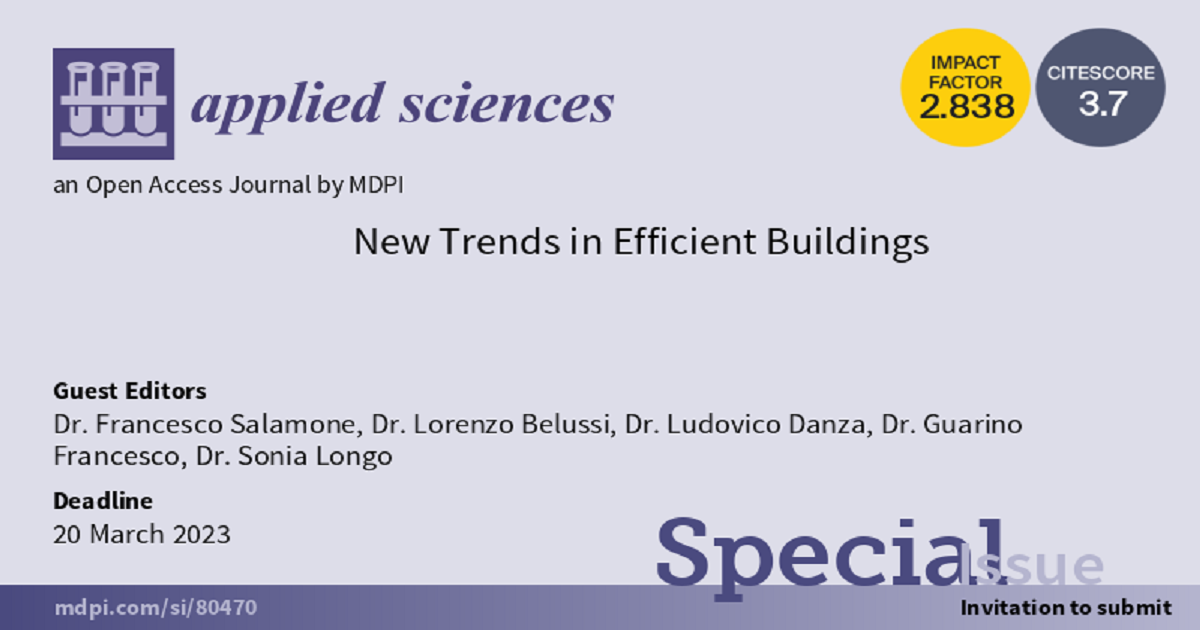New Trends in Efficient Buildings
A special issue of Applied Sciences (ISSN 2076-3417). This special issue belongs to the section "Energy Science and Technology".
Deadline for manuscript submissions: closed (20 March 2023) | Viewed by 18509

Special Issue Editors
Interests: sustainability; energy efficiency in building; thermal comfort; indoor environmental quality; environmental monitoring systems; supervised machine learning; data analysis; parametric design; additive manufacturing
Special Issues, Collections and Topics in MDPI journals
Interests: energy efficiency; zero-energy building; indoor environmental quality; life cycle assessment
Special Issues, Collections and Topics in MDPI journals
Interests: energy efficiency; zero-energy building; indoor environmental quality; sustainable buildings
Special Issues, Collections and Topics in MDPI journals
Interests: life cycle assessment; ecodesign; net-zero energy buildings; environmental sustainability; sustainable buildings; renewable energy technologies
Special Issues, Collections and Topics in MDPI journals
Interests: life-cycle assessment; energy; sustainable development; life cycle thinking; environmental impact assessment; environment; renewable energy technologies; environmental analysis; sustainable consumption and production; sustainable agriculture
Special Issues, Collections and Topics in MDPI journals
Special Issue Information
Dear Colleagues,
The role of the building sector is central in energy and environmental agendas of international and national policy makers, as improving the efficiency of the building stock is crucial to meet the requirements of the New Green Deal. Building renovation and the construction of new buildings must be based on principles that go beyond the energy efficiency but include several issues in a truly holistic perspective:
- economic affordability
- circularity and life cycle thinking
- users’ and workers’ satisfaction and comfort
- integration of renewable energy generation systems
- integration of smart technologies for smart buildings
This Special Issue aims at collecting original research that addresses the theme of efficient buildings in a broader way, including different perspectives and analyses.
The concepts of Efficient Buildings (EBs), Passive Houses, Zero-Energy Buildings (ZEBs), and Positive-Energy Buildings (PEBs) have been developed primarily to decrease the operational energy consumption of the building sector. The scientific literature is rich in examples that propose calculation methodologies to assess the energy performance of efficient buildings and related operational carbon emissions.
Other scientific studies have emphasized the effects of efficient buildings in terms of embodied impacts and emissions (carbon footprint or a more structured life cycle assessment) and operational/life cycle costs (LCC) or, even, in terms of some co-benefits that can be achieved beyond the direct energy saving that are difficult to be quantified: health benefits, increased productivity, added value of a building, and increased value of the context.
Some other studies have demonstrated the possibility of using different Artificial Intelligence (AI) approaches to analyse occupant presence and behaviours to optimize energy consumption in efficient buildings.
In this context, this Special Issue welcomes original research covering all aspects concerning the energy efficiency assessment. Topics of interest include but are not limited to:
- all-encompassing assessment methodologies
- energy and design implications
- comfort-related issues
- sustainability of the built environment (e.g., environmental, economic, social, etc.)
- interactions between occupants and the building
- AI-based applications
Dr. Francesco Salamone
Dr. Lorenzo Belussi
Dr. Ludovico Danza
Dr. Francesco Guarino
Dr. Sonia Longo
Guest Editors
Manuscript Submission Information
Manuscripts should be submitted online at www.mdpi.com by registering and logging in to this website. Once you are registered, click here to go to the submission form. Manuscripts can be submitted until the deadline. All submissions that pass pre-check are peer-reviewed. Accepted papers will be published continuously in the journal (as soon as accepted) and will be listed together on the special issue website. Research articles, review articles as well as short communications are invited. For planned papers, a title and short abstract (about 100 words) can be sent to the Editorial Office for announcement on this website.
Submitted manuscripts should not have been published previously, nor be under consideration for publication elsewhere (except conference proceedings papers). All manuscripts are thoroughly refereed through a single-blind peer-review process. A guide for authors and other relevant information for submission of manuscripts is available on the Instructions for Authors page. Applied Sciences is an international peer-reviewed open access semimonthly journal published by MDPI.
Please visit the Instructions for Authors page before submitting a manuscript. The Article Processing Charge (APC) for publication in this open access journal is 2400 CHF (Swiss Francs). Submitted papers should be well formatted and use good English. Authors may use MDPI's English editing service prior to publication or during author revisions.
Keywords
- energy performance
- Intelligent energy management
- indoor occupant comfort
- building energy performance
- renewable energy technologies
- sustainable buildings
- smart buildings








